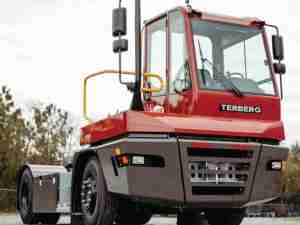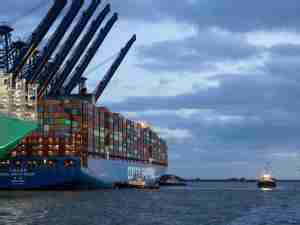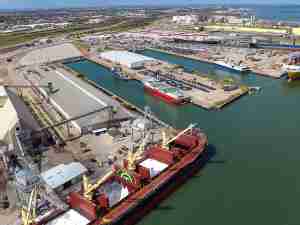Containership Xiamen is part of new TP20 service from emerging Southeast Asia/Vietnam and China hub
The first vessel of a new Southeast Asia/Vietnam and China container service from Maersk Line arrives this week at the Seagirt Marine Terminal of the Helen Delich Bentley Port of Baltimore. The Xiamen is part of a Transpacific/Panama Canal service named the TP20 that includes up to 13 vessels with carrying capacities of 4,500-plus Twenty-foot Equivalent (TEU) containers. It’s the first direct ocean service to Southeast Asia for the Port of Baltimore.
Vessels in Maersk’s new TP20 Loop service originate in the Port of Vung Tao, Vietnam, load cargo in the ports of Ningbo-Zhoushan, China and Shanghai, China and then sail through the Panama Canal discharging goods in Norfolk and Baltimore – the only two U.S. ports in this service string.
“The arrival of the first ship in the new Maersk Line service is a milestone for the Port of Baltimore, and another example of our growing international reputation for stellar service and outstanding access to markets across America,” said Maryland Department of Transportation Secretary Greg Slater. “The Port is continuing to show the power of its workforce and its infrastructure to fuel Maryland’s economy.”
“We welcome the Xiamen, the first ship in the new Maersk TP20 service to the Port of Baltimore,” said MDOT MPA Executive Director William P. Doyle. “This new ocean service is helping us prime the pump in advance of the Howard Street Tunnel project’s double stack rail to the Midwest. In addition, it allows ocean carriers, non-vessel operating common carriers, and freight forwarders to market the Baltimore region’s e-commerce centers to Southeast Asia manufacturers. This is also a result of the great public-private partnership that we have with Ports America Chesapeake --- capitalizing on the substantial investments made over the past several years.”
The service reflects a need for more cargo gateways in the United States, as port congestion is at an all-time high. With many local distribution, sorting, and fulfillment centers, Baltimore is a prime gateway for containers with goods heading to the e-commerce market and for cargo sent to the Midwest via rail. The Port of Baltimore has a proven track record of handling mid-size container ships that will be utilized by Maersk in the new Southeast Asia service. The Port has served 23 “ad hoc” ships over the past year – vessels diverted to Baltimore that were not on a regularly scheduled service call – totaling more than 35,000 TEU.
“In partnership with the Maryland Port Administration, we’re excited to welcome the Xiamen to the Seagirt Marine Terminal,” said Bayard Hogans, vice President of Ports America Chesapeake. “As the first ship call of the new Maersk TP20 Service, the arrival of the vessel marks the beginning of the Port of Baltimore’s direct ocean service to and from Southeast Asia, increasing our global reach.”
“The men and women of ILA 333 welcome this new container service to the Port of Baltimore,” said Scott Cowan, president of International Longshoremen’s Association Local 333. “With the new cranes coming, this is a very exciting time for the Port and the workforce. We look forward to even more work opportunities that will come with additional larger ships.”
Later this week, the Port of Baltimore is expected to take delivery of four additional ultra-large, Neo-Panamax cranes that will greatly boost container capacity. Dredging was completed in April to deepen a second berth at the Seagirt Marine Terminal to 50-feet. Baltimore is one of a few East Coast ports with the ability to handle some of the world’s largest vessels, and the second 30-foot-deep berth will allow two of these massive ships to be serviced at the same time. After a period of testing, the new cranes are expected to be operational by the end of the year.
Complementing the new Seagirt berth are plans to expand Baltimore’s Howard Street Tunnel, which received final federal environment approval this summer under the National Environmental Policy Act. The expanded tunnel will allow for double-stacked container rail cars, clearing a longtime hurdle for the Port and giving the East Coast seamless double-stack capacity from Maine to Florida.
The Howard Street Tunnel project involves clearance improvements in the tunnel and at 22 other locations between Baltimore and Philadelphia, and is the result of public-private investment from the federal government, Maryland, CSX, and others. Completion of the tunnel expansion is expected to increase the Port’s business by about 160,000 containers annually, and will generate about 6,550 construction jobs and an additional 7,300 jobs from the increased business.
The Port generates about 15,300 direct jobs, with nearly 140,000 jobs overall linked to Port activities. The Port ranks first among the nation’s ports for volume of autos and light trucks, roll on/roll off heavy farm and construction machinery, and imported gypsum. It ranks 11th among major U.S. ports for foreign cargo handled and 10th for total foreign cargo value.

_-_28de80_-_939128c573a41e7660e286f3686f2a6e25686350_yes.jpg)








